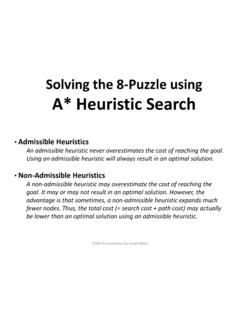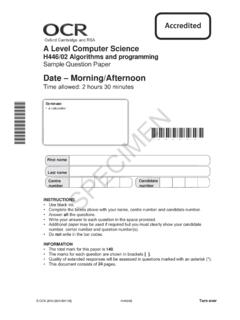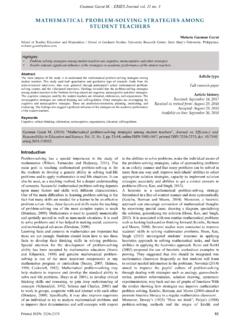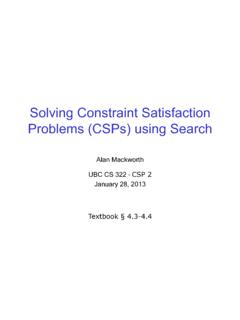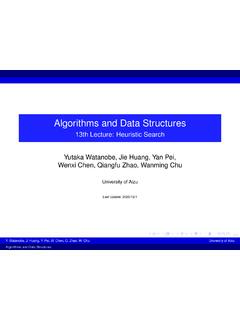Transcription of 1. Design of Intelligent System Using PEAS 1.2 Vacuum ...
1 1. Design of Intelligent System Using PEAS Automated Taxi Driver Vacuum Cleaner Agent A Music Composer An Aircraft Autolander An Essay Evaluator A Robotic Sentry Gun for the Keck Lab Medical Diagnosis System 2. Problem Definition with State Space Representation Implement Water Jug Problem Using Problem Formulation Implement Wumpus World Problem Using Problem Formulation 3. Uniformed search Techniques Implement Path Finding in Maze Using Depth-First search (DFS) Implement Water Jug Problem Using Breadth-First search (BFS) 4. Informed search Technique Implement 8-Puzzle Problem Using Hill Climbing Implement 8-Puzzle Problem Using Best-First search Implement Tic-Tac-Toe Using A* Algorithm Implement 8-Puzzle Problem Using A* Algorithm Implement Travelling Salesman Problem (TSP) Using A* Algorithm Implement 8-Queen Problem with heuristic Function (Informed search ) 5.
2 Adversarial search Implement Minimax Algorithm 6. Constraint Satisfaction Problem Implement 8-Queen Problem Implement Map Colouring Problem Implement Crypt Arithmetic Problem 7. Design of a Planning System Using STRIPS (Block World Problem ) 8. Implementation of Bayes' Belief Network (Probabilistic Reasoning in an Uncertain Domain) 9. Implement Resolution Inference Rule Using Prolog 10. Ontology Creating, Editing and Authoring Using Prot g Tool. 11. Inductive Learning Using Weka Tool Implement Decision Tree Learning 12. Study of Seiko DTRANS RT 3200 Robot 13. Mini Expert System Using PROLOG. 14. Programming Using Python Water Jug Problem Using Python Wumpus World Problem Using Python Eight Puzzle Problem Using Python Tic-Tak-Toe Game Using Python Eight/N- Queen Problem Using Python Minimax &Alpha Beta Pruning AI Algorithm in Tic-Tac-Toe Using Python Constraint Satisfaction Problem Using Python 15.
3 Construction of a Domain-Specific Chatbot Using Natural Language Processing Techniques Design of Intelligent System Using PEAS Automated Taxi Driver Vacuum Cleaner Agent A Music Composer An Aircraft Autolander An Essay Evaluator A Robotic Sentry Gun for the Keck Lab Medical Diagnosis System Aim: To understand the concept of PEAS. PEAS: PEAS stands for performance environment actuators sensors. a. Automated Taxi Driver In designing an agent, the first step must always be to specify the task environment as fully observable. To understand PEAS in a better way, let us try to analyse the complex problem of automatic taxi driver which is currently beyond the capabilities of existing technology. We would consider characteristics of PEAS for description of taxi's task environment.
4 Performance measure is the first to which we would like an automatic driver to Aspire. Desirable measures include getting correct destination, minimising fuel consumption, no wear and tear, minimising trip time and cost, minimising violation of traffic laws and disturbance to other drivers, minimising safety and passenger comfort and maximizing profit. But in this scenario, some of the goals may conflict, so there will be some trade off involved. Environment: The basic question that comes in the mind is what is the driving environment that a taxi will face? A taxi driver will face with a variety of roads, ruler lines and urban Valley to 12 Lane Freeway. The roads contain other traffic, pedestrians, stray animal, roads work, police potholes and cars.
5 A taxi must also interact with potential and actual passengers. There might be some restriction on driving, such as left-hand side driving as in India, Japan, etc., or right-hand side driving. Otherwise the roads may be soaring temperature, desert areas and all snowfall regions like Kashmir. Thus, more restricted the environment, easier the Design problem. Actuators: The actuators available to an automated taxi will be more or less same as those available to human driver( , control over engine through the accelerator and control over steering and breaking). In addition, it will output to a display screen or voice synthesizer talk back to passengers and perhaps some way to communicate with other drivers or vehicle politely or otherwise.
6 Sensors: The sensors will play a crucial role in determining where the taxi actually is, what else is on the road and how fast it is going. The basic sensors should therefore include one or more TV cameras, the tachometer and the odometer. To control the vehicle properly, especially on curves, it will also need to know the mechanical state of vehicle so it will need the usual array of engine and electrical System sensors. It might have instruments that are not available to average human driver, a satellite global positioning System (GPS) to give accurate position information with respect to an electronic map and infrared solar sensors to detect distance to other cars and obstacles. Finally, it will require keyboard or microphone for passenger to request a destination.
7 Performance measure safe fast legal comfortable trip maximize profit Environment roads are the traffic pedestrian customers Activators steering accelerator break horn display Sensors, camera, sonar speedometer, odometer, GPS, etc. b. Vacuum Cleaner Agent Figure 1 iRobot Roomba series. Performance: Cleanness, efficiency: distance travelled to clean, battery life, security. Environment: Room, table, wood floor, carpet, different obstacles. Actuators: Wheels, different brushes, Vacuum extractor. Sensors: Camera, dirt detection sensor, cliff sensor, bump sensors, infrared wall sensors. c. Music Composer Performance Measures - number of measures composed per unit time, number of instruments considered, ease of play by a human, range of frequencies within human audible zone, melodic, harmonic and rhythmic criteria.
8 Environment Software Actuator None required, this can be a pure softbot Sensors Code that reads in basic parameters d. Aircraft Autolander Performance Measure: Lack of damage to plane, other aircraft or ground structures, lack of injuries to passengers or ground crew or other innocent observers, cargo remains intact, fuel economy, lands at correct airport on correct runway, doesn't take too long Environment: Lower atmosphere and surface of planet Earth. Actuators: Throttle, landing gear, rudders, ailerons, flaps .. Sensors: Cameras, Altimeter, Speedometer, other meters, .. e. Essay Evaluator Performance Measures : awards scores for quality, penalizes crap, detection of plagiarism, impartiality, usefulness of explanation of grading.
9 Environment: Software Actuator: None, this can be a pure softbot Sensors: File reading software, (perhaps even OCR) f. Robotic Sentry Gun for the Keck Lab Performance Measures Percentage of correct targets hit, lack of hitting friends, minimal energy consumption, .. Environment: The Keck Lab Actuator: Gun, trigger, motors, camera, .. Sensors: Camera, sonar, bump sensors, .. g. Medical diagnosis System Performance measure: Healthy patient, minimize costs, lawsuits Environment: Patient, hospital, staff Actuators: Screen display (questions, tests, diagnoses, treatments, referrals) Sensors: Keyboard (entry of symptoms, findings, patient's answers) Problem Definition with State Space Representation Implement Water Jug Problem Using Problem Formulation Aim: Implement water jug problem Using BFS or DFS (Un-Informed search ).
10 Theory: Problem Statement For further explanation read Section of Chapter 3. In the water jug problem in Artificial Intelligence, we are provided with two jugs: one having the capacity to hold 3 gallons of water and the other has the capacity to hold 4 gallons of water. There is no other measuring equipment available and the jugs also do not have any kind of marking on them. So, the agent s task here is to fill the 4-gallon jug with 2 gallons of water by Using only these two jugs and no other material. Initially, both our jugs are empty. So, to solve this problem, following set of rules were proposed: Production rules for solving the water jug problem Here, let x denote the 4-gallon jug and y denote the 3-gallon jug. Initial State Condition Final state Description of action taken 1.
